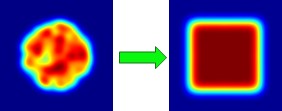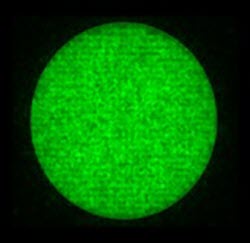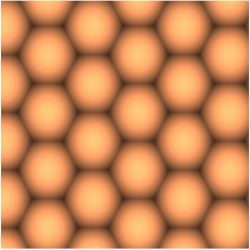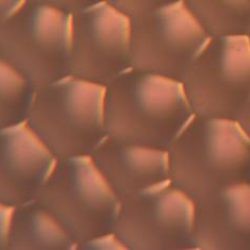Beam homogenizer definition
A beam homogenizer, a.k.a. optical homogenizer or diffuser, is an optical component or device used to generate a uniform distribution from the input beam projected onto it.
The laser homogenizer applies a random or quasi-random modification to a single-mode or multi-mode input beam in a way that the irregularities of it are diffused and so, the output beam has a well defined near constant intensity profile at the far field or focal plane over a certain area with very low intensity outside that area.

Types of laser beam homogenizers
The homogenizer principle of operation is a rather simple one: spread the laser energy, typically concentrated at the center of the beam, by scattering the beam so that it overlaps itself multiple times, creating a beam with a larger divergence angle than the original beam, but whose energy is spread more uniformly. Thus, a simple murky or rough glass can be considered a laser homogenizer, however, it will be a rather poor solution for beam homogenizing with low efficiency and will only provide a gaussian shape.
Different applications require different properties of homogenization quality and optical efficiency, and thus there is a number of approaches utilizing varying homogenization working principles, including:
- Microlens array placed in a conjugate plane
- Random Micro lens arrays, or Broadband Diffusers
- Diffractive Homogenizers
- Multifaceted mirrors
- Waveguides or multimode fibers
- Rotating diffuser plates
and more
Holo/Or offers three different types of optical homogenizers – diffractive homogenizers, microlens arrays and broadband diffusers.

Diffractive homogenizer working principle and suitable use cases
A diffractive homogenizer splits an incident laser beam that is propagated through it in quasi-random directions, and thus utilizes the interference principle to diffuse the split beams into almost any desired shape or intensity distribution, with precise angle and size in the far field or focal plane. This sort of diffuser is a quasi-periodic structure that is not sensitive to beam centration or size, as long as it is above some minimal beam diameter determined by the diffuser angle.
The diffractive diffuser is designed for a specific wavelength, and is the preferred solution in terms of unparalleled intensity profile control, uniformity and a sharp, diffraction limited transfer region. Diffractive diffusers are not limited to symmetrical or flat distributions, and can shape light into arbitrary shapes, including multiple rectangles or different sized spots, as well as gradient intensity profiles.
Like all diffuser types, Diffractive diffusers work best with highly incoherent multi-mode beams (M2>5), as the uniformity of overlap improves with decreasing coherence . For a highly coherent laser beam – a top-hat beam shaper would be advised.

Microlens array as homogenizer working principle and suitable use cases
A microlens array is an array of microlenses with fixed pitch and radius. Each lens takes a fraction of the incoming beam and images the lens sub-aperture shape, with the light from all lens sub apertures overlapping, thus obtaining a homogenized beam.
Microlens arrays tend to have better homogenization performance when the number of microlenses the beam covers is large, and under such conditions the transfer region, as a rule, suffers. Thus they offer less sharp shaped distributions compared to diffractive diffusers, and are limited to shaping to possible aperture shapes, i.e hexagonal, square, line and rectangle only.

Broadband Diffuser homogenizer working principle and suitable use cases
A broadband diffuser (a.k.a an engineered diffuser) is a hybrid solution designed by Holo/Or especially for customers with multiple wavelength laser systems, who are interested in a single component beam shaping and homogenizing solution which will provide the same output shape for different wavelengths incident beams in the same optical path.
The broadband diffuser is a micro-refractive solution based on sub apertures with refractive elements having a random component inside each aperture. These hybrid diffuser elements combine refractive lens power with direct diffusion, enabling arbitrary shaping of the light including round diffusion, while maintaining high diffusion efficiency similar to the one achieved in micro lens arrays.
Applications and uses of laser beam homogenizer
Beam homogenizers are often used in laser (or other light source) systems where an even area surface treatment is beneficial. This may be to either increase a system’s throughout, or to avoid creating hot-spots that can cause burns or uneven processing of the area.
Examples for known applications include:
- Medical and aesthetic applications where surface treatment is advised (hair removal, tattoo removal and more)
- Material processing applications including welding, brazing and surface treatments such as metal hardening and remelting, laser cleaning and laser powder sintering.
- Laser projection for displays and light shows
- Time of flight 3D sensing
TL;DR - Q&A
What is a laser beam homogenizer?
A beam homogenizer is an optical component used to transform any input beam into a uniform intensity distribution, often a flat-top distribution.
What are beam homogenizers used for?
beam homogenizers are used in applications where an even intensity distribution over an area or a defined surface is required, mostly thermal laser processes.
What is the beam homogenizer working principle?
Different homogenizers operate under different working principles, but the general idea is the same: applying a random or quasi-random modification to the input beam to diffuse it’s irregularities and provide a uniform intensity profile with a well-defined shape at the output.
What kind of beam homogenizers are there?
there are many different types of beam homogenizers providing different output properties. One ought to choose the homogenizer solution that best fits their system input beam properties and output requirements. The most common solutions include microlens arrays, broadband diffusers and diffractive homogenizers.
What kind of beam homogenizer should I use?
Diffractive diffusers offer the greatest freedom in terms of shaping, but are limited to a single wavelength (or harmonies of the same laser) . Broadband diffusers offer the best cost effective solution in terms of efficiency while maintaining shaping freedom, and are polychromatic. Microlens arrays are good mostly for low cost homogenization to predetermined shapes, where the presence of grid-like-artifacts is not critical, or the light is highly incoherent.

